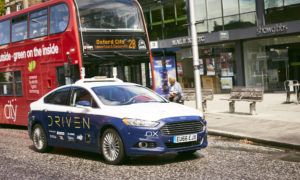According to autonomous vehicle (AV) software developer Oxbotica, the self-driving fleet that it is trialing on London’s complex and congested streets are required to make 150 independent vehicle detections every second and can detect traffic lights in 1/2,000th of a second.
The Oxford-based company is currently trialing five fully autonomous vehicles in London as part of the Driven consortium, an £13.6m (US$16.9m) research project that seeks to address fundamental real-world challenges facing self-driving vehicles such as insurance, cyber-security and data privacy. Oxbotica has completed extensive testing in London since initial trials in the Borough of Hounslow in December 2018, with the capital proving the ideal proving ground due to its classical architecture and complex road networks; it ranked as the sixth most congested city in the world and records over 30,000 road casualties per year. The advanced journey learnings from London can then be applied to improve safety around the globe using its machine learning algorithms and advanced vision perception that reacts faster than the human eye.
As the lead partner in the Driven consortium, which began in July 2017, Oxbotica will showcase its software capability as part of a live demonstration in London later this month, as part of a 30-month ground-breaking research project. The ambitious program will see a fleet of fully autonomous vehicles being deployed in urban areas and on motorways, culminating in an end-to-end journey from London to Oxford. These vehicles will be operating at SAE Level 4 autonomy, meaning they have the capability of performing all safety-critical driving functions and monitoring roadway conditions for an entire trip, with zero-passenger occupancy.
 Oxbotica is already using its pioneering Universal Autonomy software system in cities, mines, airports, quarries and ports. The system can run on everyday computer hardware with similar power to an average desktop PC. The software uses two strands to achieve Universal Autonomy:
Oxbotica is already using its pioneering Universal Autonomy software system in cities, mines, airports, quarries and ports. The system can run on everyday computer hardware with similar power to an average desktop PC. The software uses two strands to achieve Universal Autonomy:
- Selenium, which is a complete end-to-end solution that works anywhere, anytime and is the equivalent of a computer operating system, pulling in data from the sensors fitted to each self-driving vehicle;
- Caesium, a data and vehicle management tool that takes uploaded data from Selenium and allows learning to be shared between vehicles anywhere in the world without the need for human input.
“As humans, we get better at driving the more experience we have, but we don’t share our learnings with each other. This is the covenant for autonomous vehicles. They learn as a community in a way that we don’t. If we have a mishap, or see something extraordinary, we aren’t guaranteed to make our neighbor or colleague a better driver,” said Oxbotica founder, Paul Newman. “Even if we could learn from each other like computers can, we can’t share at scale, across vast numbers and we can’t do it all the time. That’s what our AI software will do for every host vehicle wherever it is in the world. Providing life-long shared learning, and with it in-depth, and continually improved knowledge of the local area, allowing our cars to not just read the roads but to predict common hazards with ever greater sophistication.”





